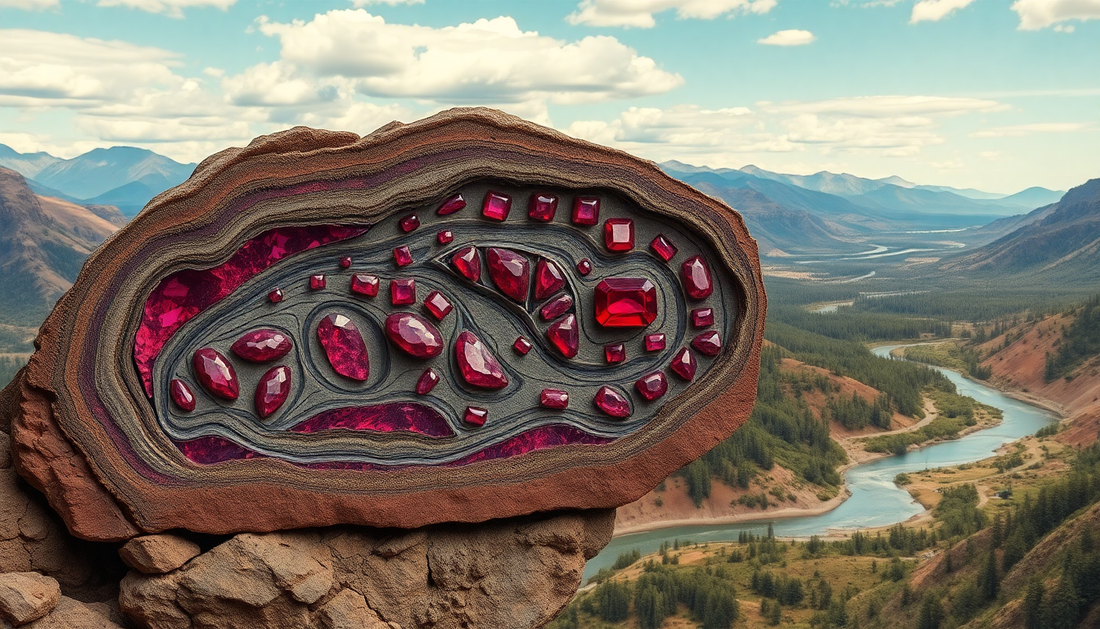
Uncovering the Secrets of Ruby: From Geological Formation to Mining Locations
Share
Ah, the captivating world of rubies - those fiery gemstones that have captivated the hearts and minds of people for centuries. As a lover of all things natural and gemological, I've always been fascinated by the intricate journey these precious stones take, from their geological formation to the various mining locations around the globe.
Let's dive into the fascinating story of rubies, shall we? These stunning gems are a variety of the mineral corundum, which is primarily composed of aluminum oxide. What sets rubies apart is the presence of chromium, which gives them their iconic deep red hue. The geological process that leads to the creation of rubies is truly remarkable.
Rubies are typically found in metamorphic rocks, such as marble and schist, where the high temperatures and pressures deep within the Earth's crust have transformed the original minerals into this captivating gemstone. The specific conditions required for ruby formation are quite unique, with the perfect balance of temperature, pressure, and chemical composition being essential.
One of the most renowned ruby mining locations is the Mogok region of Myanmar (formerly Burma). This area, often referred to as the "Valley of Rubies," has been a hub of ruby production for centuries, with the gems being highly prized by royalty and the elite. The rubies found in Mogok are renowned for their exceptional clarity, depth of color, and overall quality.
Another significant ruby mining location is the Pailin region of Cambodia. Here, the rubies are known for their slightly purplish-red hue, which is a result of the unique geological conditions in the area. The mining process in Pailin involves both alluvial and primary deposits, with the gems being extracted from the soil and rock formations.
Interestingly, rubies can also be found in other parts of the world, such as the Himalayan region of Pakistan, the Luc Yen district of Vietnam, and the Mong Hsu region of Myanmar. Each location produces rubies with their own distinct characteristics, making them highly sought after by collectors and jewelry enthusiasts alike.
As you can see, the story of rubies is one of geological wonder and human ingenuity. From their formation deep within the Earth's crust to the intricate mining processes that bring them to the surface, these captivating gemstones continue to captivate and inspire us. So, the next time you admire the fiery glow of a ruby, take a moment to appreciate the incredible journey it has taken to reach your hands.
The Geological Formation of Rubies
Rubies are formed through a complex process that involves the transformation of the mineral corundum under specific geological conditions. The key factors that contribute to the formation of rubies include:
- High temperatures and pressures within the Earth's crust, typically found in metamorphic rock environments
- The presence of chromium, which is the element that gives rubies their distinctive red color
- The perfect balance of chemical composition, with the right amounts of aluminum, oxygen, and chromium
These conditions are often found in regions where tectonic plates collide, such as the Himalayan mountain range or the Mogok region of Myanmar. The intense heat and pressure in these areas can cause the original minerals to undergo a transformation, leading to the creation of the stunning ruby gemstones.
Exploring Ruby Mining Locations
While rubies can be found in various parts of the world, there are a few regions that are particularly renowned for their ruby production. Let's take a closer look at some of the most famous ruby mining locations:
Mogok, Myanmar
The Mogok region of Myanmar, also known as the "Valley of Rubies," has been a hub of ruby production for centuries. The rubies found in this area are renowned for their exceptional clarity, depth of color, and overall quality, making them highly sought after by collectors and jewelry enthusiasts.
Pailin, Cambodia
The Pailin region of Cambodia is another significant ruby mining location. The rubies found here are known for their slightly purplish-red hue, which is a result of the unique geological conditions in the area. The mining process in Pailin involves both alluvial and primary deposits, with the gems being extracted from the soil and rock formations.
Himalayan Region, Pakistan
The Himalayan region of Pakistan is also home to a rich source of ruby deposits. The rubies found in this area are known for their slightly different hue, often with a more pinkish tone, due to the unique geological conditions in the region.
These are just a few of the many ruby mining locations around the world, each with its own distinct characteristics and geological history. As you can see, the journey of these captivating gemstones is truly a testament to the wonders of our planet and the incredible processes that shape the natural world.